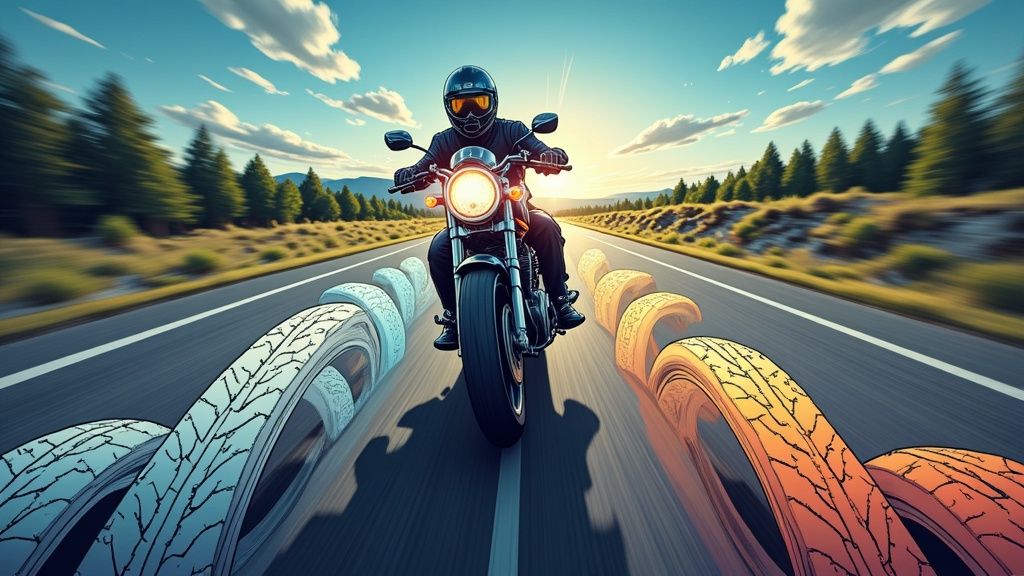
The Complete Motorcycle Tire Pressure Guide: Essential Safety and Performance Strategies
Why Proper Tire Pressure Is Critical for Motorcycle Safety
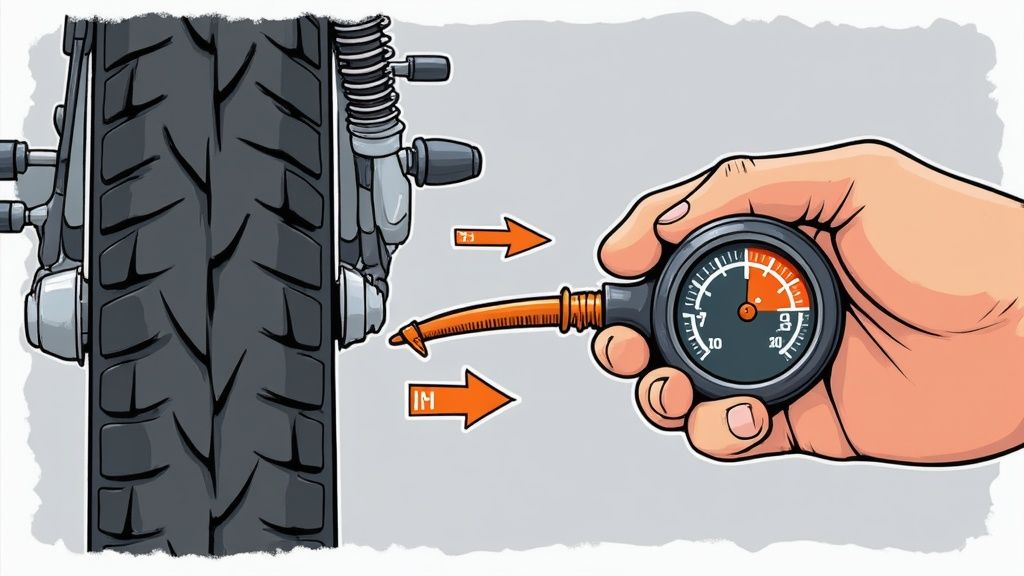
Proper tire pressure is essential for motorcycle safety and performance. This basic maintenance task directly affects how your bike handles on the road and can mean the difference between a safe ride and a dangerous one.
The Dangers of Incorrect Tire Pressure
Underinflated tires make your bike harder to control and decrease fuel efficiency. The experience is similar to riding a bicycle with soft tires - steering becomes sluggish and requires more effort. On the flip side, overinflated tires create a harsh ride and reduce the tire’s contact with the road, which is particularly risky when cornering.
Poor tire pressure maintenance leads to serious safety risks. Each year, riders face accidents due to improperly inflated tires that reduce stability and grip. When tires are underinflated, their sidewalls flex excessively and build up heat, making them more likely to fail from normal road impacts. This heat buildup can cause hidden internal damage that might lead to blowouts. Additionally, underinflated tires increase the risk of hydroplaning in wet conditions. Learn more about tire safety here
How Proper Tire Pressure Enhances Safety
The right tire pressure creates optimal contact between your tires and the road, giving you maximum traction and stability. This results in better handling, more predictable braking, and improved response to steering inputs. When your tires are properly inflated, you can take corners with confidence knowing you have solid grip.
The Science Behind Tire Pressure and Stability
Understanding tire pressure and stability comes down to physics. The contact patch - where your tire meets the road - changes significantly based on air pressure. The right pressure creates an ideal-sized contact patch that balances performance and grip. Too little air means reduced contact area and stability, while too much pressure concentrates contact in the tire’s center. Both scenarios affect how well your tires grip the road, especially during turns and stops.
Regular tire pressure checks using an accurate gauge and following manufacturer specifications are simple but crucial steps for safe riding. This basic maintenance can prevent accidents and help ensure you stay safe on every ride.
Understanding Recommended Tire Pressure Ranges
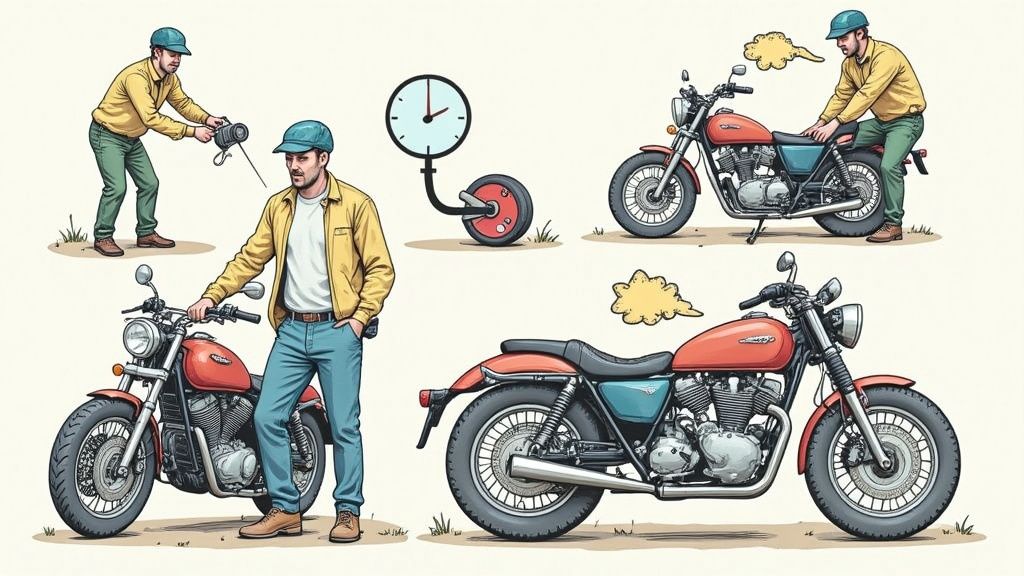
Getting tire pressure right requires more than just following the PSI numbers on your motorcycle’s sticker. The ideal pressure depends on multiple factors that affect how your bike performs and handles on the road.
Finding Your Baseline Pressure
Start by checking the pressure recommendation on your swingarm sticker or in your owner’s manual - this gives you a baseline to work from. The standard range for motorcycle tires is typically between 28 to 40 PSI, with 32 PSI being common for good traction. Your specific needs may vary based on:
- Total rider and bike weight
- Type of riding terrain
- Load being carried
Keep in mind that rear tires generally need 5-10 PSI more pressure than front tires due to weight distribution. Heavier bikes and riders should aim for the higher end of the recommended range. Learn more about tire pressure basics.
The Impact of Riding Style and Conditions
Your riding habits play a big role in determining ideal tire pressure. Sport riders who lean hard into corners often prefer slightly lower pressures for better grip. Daily commuters and touring riders typically run higher pressures for improved stability and fuel economy.
Road conditions matter too - smooth highways allow for different pressure settings compared to rough back roads. The key is finding the sweet spot that matches your specific riding environment.
Adapting Pressure for Different Scenarios
Different types of riding need different pressure setups. For regular commuting, the manufacturer’s recommendation usually works well. When loading up for a long trip, increase pressure (especially in the rear) to handle the extra weight and prevent overheating. Remember to also account for major temperature changes, as this affects tire pressure significantly.
Mastering Temperature Effects on Tire Pressure
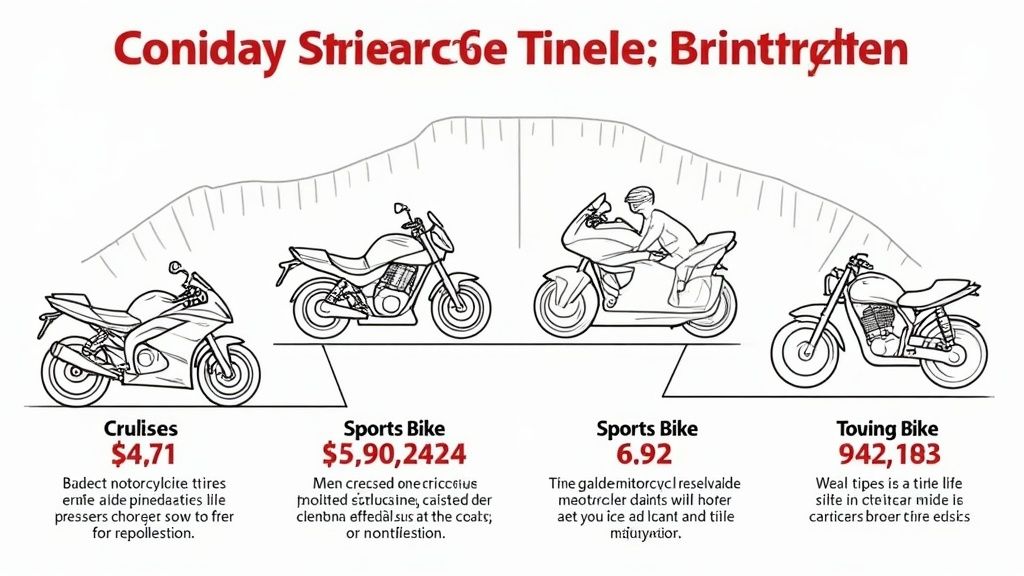
Proper tire pressure is essential for safe motorcycle riding and peak performance. Temperature changes can significantly impact tire pressure, making it a key factor that every rider needs to understand.
The Science of Temperature and Tire Pressure
When temperatures rise and fall, tire pressure follows. For every 10-degree temperature change, your tire pressure shifts by about 2%. This happens because of basic physics - gases expand when heated and contract when cooled. For a deeper dive into the numbers, check out Dairyland Insurance’s guide on tire pressure.
Checking Tire Pressure: Cold vs. Hot
You should always check tire pressure when the tires are “cold.” This means your motorcycle has been sitting still for at least three hours. Checking right after a ride will give you incorrect readings since the tires heat up during use, which temporarily increases pressure.
Adjusting for Different Weather Conditions
Weather shifts can trick you into under or over-inflating your tires. On cold mornings, tires inflated to the right pressure may become underinflated as they warm up during your ride. The opposite happens in hot weather - proper pressure in the afternoon heat could mean overinflated tires when evening temperatures drop.
Practical Strategies for Accurate Pressure Readings
Here’s how to keep your tire pressure spot-on despite changing temperatures:
- Weekly Checks: Make tire pressure checks part of your weekly routine, especially before long rides
- Get Good Tools: Buy a high-quality digital pressure gauge for better accuracy
- Watch the Weather: For big temperature swings, adjust pressure slightly based on expected riding conditions
- Load Matters: Factor in passenger weight and cargo when setting pressure, along with temperature effects
By understanding how temperature affects your tires and following these guidelines, you’ll be better equipped to maintain safe, optimal tire pressure in any weather. Remember - proper tire maintenance is one of the most important things you can do for a safe ride.
Optimizing Performance Through Precise Pressure Management
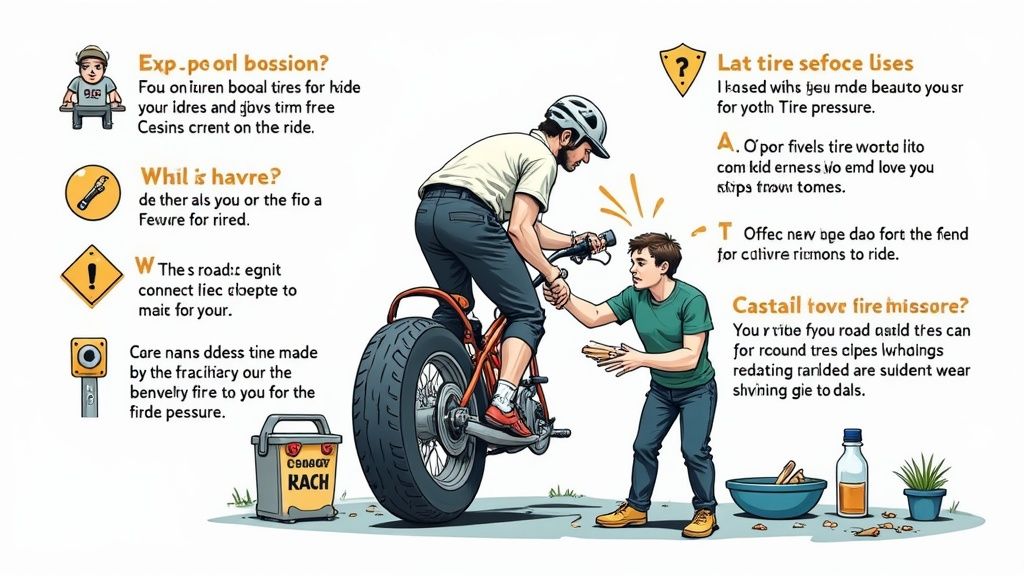
Getting your tire pressure right does more than just keep you safe - it can make a huge difference in how your motorcycle performs. Even small pressure adjustments affect everything from handling to acceleration and braking. Understanding this relationship is key to getting the most out of your bike.
The Impact of Pressure on Handling
Your tires are your only connection to the road. With proper inflation, they provide a stable contact patch that gives you predictable, responsive control. Underinflated tires make your bike feel heavy and slow to respond - similar to driving a car with flat tires. Overinflated tires reduce your grip by minimizing road contact, which can be dangerous when cornering.
Acceleration and Braking Efficiency
Tire pressure plays a vital role in performance. The right pressure helps transfer maximum power from your engine to the pavement for better acceleration. It also gives you the grip needed for effective braking - crucial in emergency situations. Research shows some interesting findings: summer tires stop better at lower pressures, while winter tires perform best at mid-range pressures. Learn more about tire pressure effects on braking at Louis Peck’s Motorcycle Guide.
Fine-Tuning Pressure for Different Riding Styles
Your riding style should influence your tire pressure choices. For relaxed cruising, staying at the higher end of recommended pressures can boost fuel economy and ride comfort. If you enjoy aggressive cornering or track days, running slightly lower pressures (while staying within specs) can improve grip and lean angle capability. Finding your ideal setup takes careful testing and observation.
Achieving the Perfect Balance
Finding your optimal tire pressure means considering your bike’s specs, how you ride, and current conditions. Regular pressure checks and small adjustments based on real-world results will help you dial in the perfect balance. Using Auto Service Logger to track your pressure settings and notes about handling can help you spot patterns and fine-tune your setup over time.
Essential Tools and Techniques for Professional-Level Pressure Management
Safe riding depends on maintaining correct motorcycle tire pressure. It involves more than just a quick visual check - professional-quality tools and proper measurement techniques are essential. Let’s explore how to manage tire pressure like an expert mechanic.
Choosing the Right Pressure Gauge
Getting accurate pressure readings begins with selecting a quality gauge. Simple stick gauges are common but can be inconsistent in their measurements, much like trying to measure something small with an unsteady ruler.
Digital gauges offer much better accuracy. These tools give clear, precise readings without the guesswork of traditional gauges. For best results, invest in a high-quality digital pressure gauge - this small cost can make a big difference in your motorcycle’s safety and performance.
Achieving Laboratory-Precise Measurements
Even the best gauge needs proper technique for accurate readings. Always check pressure when tires are cold - meaning the bike hasn’t been ridden for at least 3 hours. Hot tires from riding will show artificially high pressure readings.
Make sure the gauge forms a tight seal on the valve stem. If you hear air hissing out, you won’t get an accurate measurement. Apply steady, consistent pressure until you see a stable reading. Following this method ensures reliable results every time.
Maintaining Your Equipment for Consistent Accuracy
Like any precision tool, pressure gauges need regular care. For digital models, check batteries often and replace as needed. With any gauge type, look for damage or wear. A faulty gauge can give wrong readings that put your safety at risk. Regular equipment checks help ensure your measurements stay accurate.
Common Mistakes and How to Avoid Them
Even experienced riders make pressure checking mistakes. One frequent error is using an uncalibrated gauge - like a kitchen scale that gradually loses accuracy over time, pressure gauges can drift and need recalibration.
Another mistake is relying only on the bike’s built-in tire pressure display. These sensors can be inaccurate and should be double-checked with a quality handheld gauge. Avoiding these errors helps ensure precise pressure readings for safer riding. Track your pressure checks and maintenance with Auto Service Logger to keep your motorcycle in top condition.
Building Your Custom Pressure Maintenance Strategy
Understanding how to maintain the correct motorcycle tire pressure takes more than just following basic guidelines. You need a strategy that matches your specific motorcycle, riding habits, and common road conditions. Here’s how to create an effective pressure maintenance plan that works for you.
Integrating Pressure Checks Into Your Pre-Ride Routine
Regular tire pressure checks are as essential for everyday riders as they are for professional racers. Making this a consistent part of your pre-ride routine helps ensure every journey starts safely.
- The “Cold Check” Rule: Always check pressure when tires are cold - after the motorcycle has been stationary for at least 3 hours. This gives you the most accurate reading.
- Check Frequency: Make it a habit to check tire pressure at least once per week. If you ride frequently or in changing weather, check more often.
Tracking Pressure Trends Over Time
Keeping records of your tire pressure readings helps you understand how your tires perform in different situations. This information is valuable for fine-tuning your maintenance routine.
- Paper Records: A basic notebook works well for logging pressure readings along with dates, temperatures, and riding conditions.
- Digital Solutions: Tools like Auto Service Logger make it easy to track pressure history alongside other maintenance tasks. These tools help identify patterns over time.
Tools for Effective Pressure Management
Having reliable tools is key to maintaining accurate tire pressure. The right equipment helps you collect consistent, trustworthy readings.
- Quality Pressure Gauge: While basic stick gauges work, a digital gauge provides more precise readings and eliminates guesswork.
- TPMS Option: A Tire Pressure Monitoring System offers real-time pressure monitoring during rides. While more expensive, it adds safety benefits, especially for long trips.
Customizable Checklists and Maintenance Logs
Creating your own inspection checklist and maintenance log helps build consistent habits and keeps important records organized.
- Pre-Ride Checklist: Include tire pressure checks alongside other vital inspections like lights, brakes, and fluids.
- Detailed Records: Keep track of pressure readings and maintenance work in one place. This history proves valuable for monitoring tire health and showing responsible ownership.
By following these guidelines and using appropriate tools, you can develop an effective tire pressure maintenance routine that improves safety and performance. Auto Service Logger offers a practical way to track pressure readings and other maintenance tasks, making it simpler to stay on top of motorcycle care.